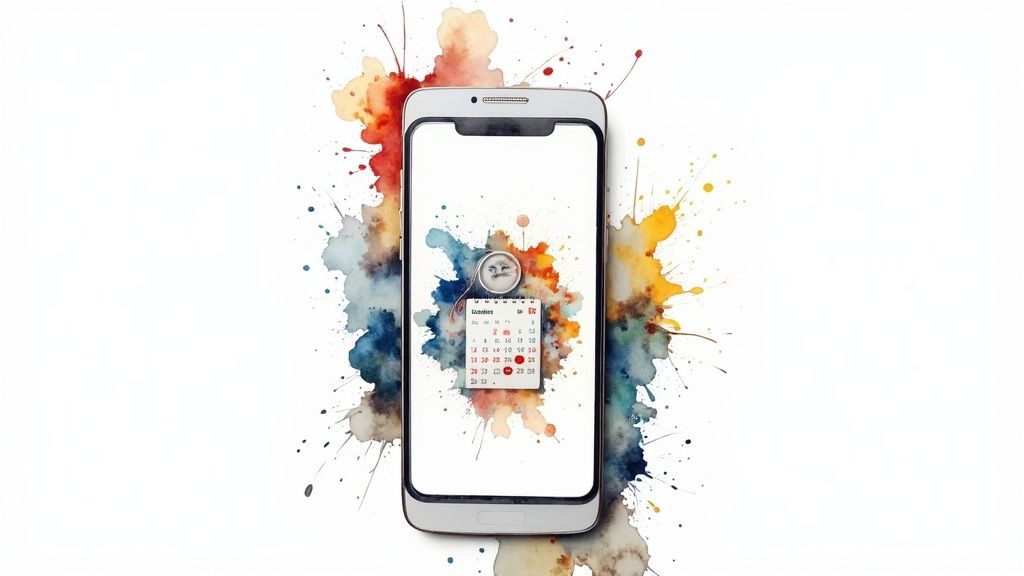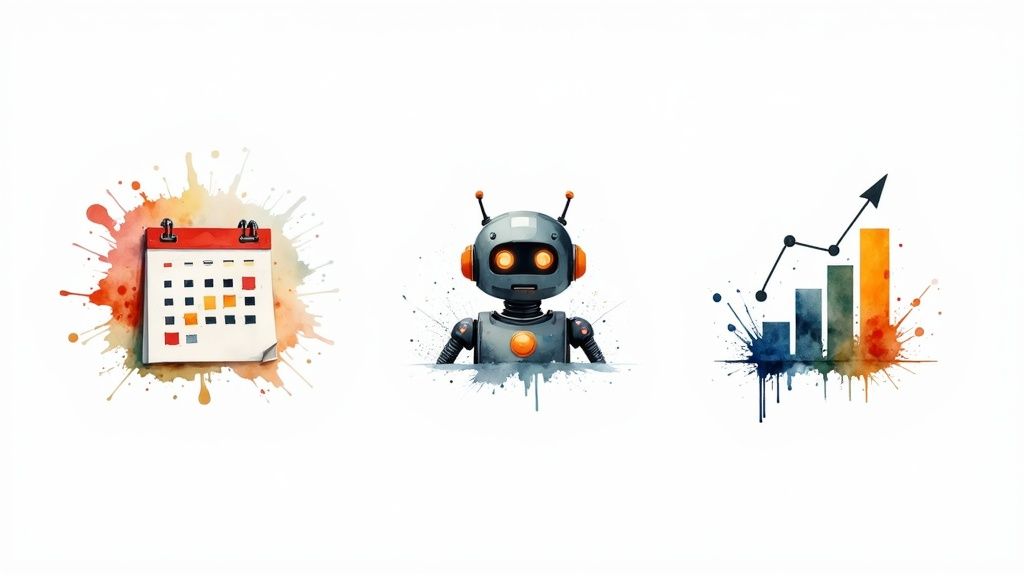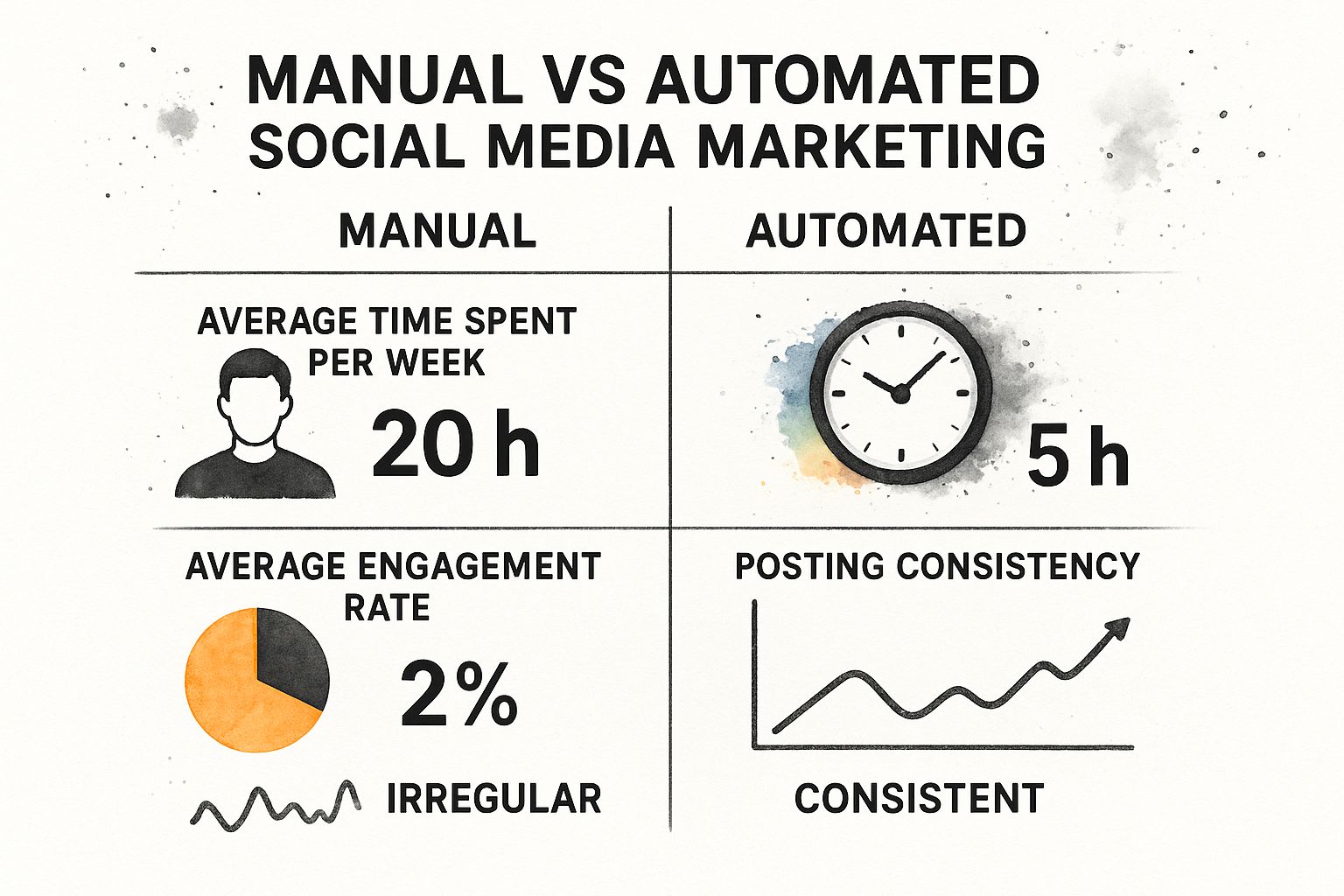Imagine you hired a super-efficient assistant for your social media. This assistant would handle all the repetitive, grunt work—scheduling posts for the perfect time, keeping an eye out for brand mentions, and pulling together weekly reports. That would free you up to focus on the stuff that actually moves the needle: crafting amazing content and having real conversations with your audience.
That's pretty much what automated social media marketing is in a nutshell. It's not about letting bots take over your accounts. It's about using smart software to handle the tedious jobs, so you can amplify the human touch where it counts the most.
What Automated Social Media Marketing Really Means

At its core, automated social media marketing means using software to manage the tasks you'd otherwise have to do by hand, over and over again. Think about it. Instead of manually logging into five different platforms to share the same update, an automation tool lets you schedule it once from a single dashboard, timing it to hit each audience when they're most active.
This approach is all about working smarter, not harder. By handing off the mechanical parts of social media management, you reclaim valuable time and mental space. That energy can then be poured into the creative and strategic work—like analyzing what’s working, brainstorming new campaign ideas, and actually engaging with your community.
Beyond Simple Scheduling
While scheduling is the feature most people think of, true social media automation goes way deeper. It's a whole suite of tools designed to help you build a consistent, responsive, and data-driven presence across every channel you're on.
Modern platforms can juggle a surprising number of tasks without you needing to constantly check in.
These capabilities often include:
- Content Curation: Automatically digging up relevant articles, videos, or images from around the web that your audience would love.
- Social Listening: Keeping an ear to the ground for mentions of your brand, your competitors, or important keywords, so you can jump on opportunities.
- Automated Reporting: Crunching the numbers and spitting out easy-to-read reports that show you exactly what's resonating with your followers and what's falling flat.
- Inbox Management: Funneling all your DMs and comments from every platform into one unified inbox, making it way easier to respond quickly and stay organized.
The goal isn't to "set it and forget it." Instead, effective automated social media marketing creates a system that supports your strategic goals, ensuring you never miss an opportunity to connect with your audience, even when you're not actively online.
Ultimately, automation is the key to consistency. And consistency is everything on social media. One study found that brands that post consistently see significantly higher engagement. Automation makes that level of activity possible, whether you're a one-person shop or a massive enterprise. It takes the daily pressure of manual posting off your plate, letting you build a reliable and professional brand that keeps your audience coming back for more.
The Real Benefits of Automating Your Social Strategy
Sure, automation saves you time, but that’s just scratching the surface. The real magic happens when you see how it impacts your brand’s health and, ultimately, your bottom line.
Think about what you could do with all those hours you get back each week. It’s not just about taking a longer lunch break; it's about reinvesting that time into high-level strategy, creative brainstorming, and having real conversations with your customers—the stuff that actually moves the needle.
Automation is like having a 24/7 brand guardian. It makes sure your content hits your global audience at the perfect time, day or night, and maintains a flawless posting schedule. That’s how you build trust and stay top-of-mind.
More Time Means More Strategy
For a small business, time is everything. Every single minute spent manually copying and pasting the same post across five different platforms is a minute you didn't spend analyzing what's working, tweaking your message, or just talking to your community. This is where automation delivers its first big win.
The numbers don't lie. By 2025, it's estimated that 47% of small businesses will be automating their social media. Why? Because it saves them an average of six hours a week. That adds up to over 300 hours per year you get back just from scheduling posts and streamlining customer chats.
And it gets better. Just automating half of your comment moderation can free up a staggering 175 hours a month. For the 64% of marketers juggling social media with a dozen other responsibilities, that kind of efficiency is a game-changer.
Automation flips your social media workflow from a reactive, time-sucking chore into a proactive, strategic operation. It frees you up to focus on what humans do best: creativity, connection, and big-picture thinking.
Consistency and Engagement Reimagined
A consistent presence is the bedrock of any successful social media account. If you post randomly, you’ll confuse your audience and the algorithms will bury you. Automation solves this by creating an unwavering content rhythm that builds reliability and keeps your followers hooked.
This consistency has a knock-on effect: it gives you more time to actually connect. When you aren't bogged down by the daily grind of scheduling, you have the bandwidth for meaningful interactions. This is how automation helps you implement powerful social media engagement strategies, making sure your brand is always part of the conversation.
With all that freed-up time, you can finally focus on:
- Faster Response Times: Jump on customer questions and feedback right away, showing them you're listening and that you value what they have to say.
- Deeper Conversations: Go beyond a simple "like" and have real discussions in the comments section.
- Proactive Outreach: Spot and connect with potential customers or brand advocates before they even come to you.
This shift from manual labor to thoughtful engagement is where brands see incredible results. To dig deeper into elevating your brand's voice and strategy, check out the resources on the rebelgrowth blog.
How Social Media Automation Actually Works

To get your head around social media automation, just think of it as a series of simple "if this, then that" commands you set up ahead of time. At its heart, the tech runs on a combination of triggers (the "if this" part) and actions (the "then that" part) to get things done for you. This system means you don't have to be glued to your screen for every single post or interaction.
The classic example everyone knows is content scheduling. You just tell the tool, "IF it is 9:00 AM on Tuesday, THEN publish this post to my LinkedIn profile." The tool handles it perfectly every time, building out a consistent posting schedule while you focus on other things.
This simple trigger-and-action model is the engine behind all social media automation. But today's tools have come a long way from just scheduling, using more complex logic—and even AI—to manage some seriously sophisticated marketing tasks.
The Building Blocks of Automation
The real magic happens when you start stacking these simple rules to create more complex, responsive systems. You can build entire workflows that listen for specific events online and react instantly, basically acting as your brand's digital eyes and ears 24/7.
Here’s how these triggers and actions play out in the real world:
- Social Listening: You can set a trigger to watch for any mention of your brand's name. The action? It could automatically drop that mention into a spreadsheet or ping your team's Slack channel so you never miss a conversation.
- Customer Service: A trigger could be a direct message containing keywords like "support" or "help." The action might be to automatically tag that message as urgent and assign it to your customer service lead, cutting down your response time.
- Lead Generation: Imagine setting up a rule where IF someone retweets a specific promotional post, THEN the system sends them an automated DM with a link to a free guide or a discount code.
This approach turns your social media from a static bulletin board into a dynamic, interactive machine. It’s all about building a framework that can anticipate what your audience needs and react in real-time, letting you scale your engagement in a way that just isn't possible manually.
How AI Kicks Things Up a Notch
While rule-based automation is a game-changer, AI takes it to a whole new level. It shifts the process from following pre-set commands to making intelligent, data-backed decisions. AI-powered platforms like rebelgrowth don't just follow your instructions; they analyze data to give you strategic advice and optimize your efforts as you go.
Instead of guessing the best time to post, an AI-driven tool sifts through your past engagement data—likes, comments, shares, and clicks—to find the precise moments your audience is most active. It then suggests an optimized posting schedule designed for maximum reach.
Even better, these tools can analyze your content's performance, showing you which formats (videos vs. carousels, for instance) and topics are hitting home with your audience. This kind of insight means you can stop throwing content at the wall to see what sticks and start creating things you know your audience will love. This intelligent layer is the future of automated social media marketing, transforming simple tools into true strategic partners.
Choosing the Right Social Media Automation Tools
Picking the right tool for automating your social media can feel like you're lost in a crowded market. With dozens of options all claiming to be the best, the secret is to look past the flashy features and zero in on what your business actually needs to win. Don't get overwhelmed—just break down the decision by looking at a few core factors.
Your budget is the most practical place to start. Tools run the gamut from free plans with basic scheduling to massive enterprise platforms that cost thousands every month. A solopreneur might just need a simple, cheap scheduler, but a larger team will need things like collaboration features, approval workflows, and deep analytics that justify a bigger investment.
Just look at how much performance can shift when you move from manual posting to an automated strategy.

The data makes it pretty clear: automation doesn't just save a ton of time, it also gives key metrics like engagement and consistency a serious boost.
Core Features to Evaluate
Once you’ve got a budget in mind, it's time to dig into the specific features that will actually make a difference in your day-to-day workflow. Not all platforms are built the same; some are rock stars in certain areas that might be way more valuable to your strategy than others. The goal is to avoid paying for bells and whistles you'll never use.
Here are the key features to keep an eye on:
- Platform Integrations: Does the tool connect with all the social networks you’re active on? You'll want to double-check that it plays nice with Instagram, TikTok, LinkedIn, and X (formerly Twitter).
- Analytics and Reporting: The best tools don't just push content out—they tell you what’s hitting the mark. Look for detailed analytics on engagement, reach, and follower growth so you can actually fine-tune your strategy over time.
- Content Curation: Some platforms are smart enough to suggest relevant articles or find user-generated content for you. This can be a huge time-saver when you're strapped for content ideas.
- Team Collaboration: If you’re not flying solo, features like post-approval workflows, different user roles, and shared media libraries are non-negotiable for keeping your brand voice consistent.
Choosing the right tool isn't about finding the one with the longest feature list. It's about finding the one with the right features that slot perfectly into your marketing process and help you hit your specific goals.
The Role of Scale and Integrations
Finally, think about how the tool will grow with your business. A platform that's perfect today might feel restrictive a year from now. So, what are your future plans? Are you looking to expand the team? Will you need to connect this tool with other software, like your CRM or a separate analytics dashboard? Picking a scalable solution now saves you the massive headache of migrating everything later.
The need for solid automation has exploded right alongside social media itself. With 5.45 billion users scattered across these platforms, they’ve become the new town square for commerce and conversation. And since nearly 26% of users are scrolling through social media for buying inspiration, brands can't afford to be inconsistent. This is where automation becomes mission-critical for getting content out on time and engaging with people when it matters most.
And remember, a well-oiled social media machine should feed the rest of your marketing funnel. A killer social campaign, for example, often sends a flood of traffic to specially designed web pages. To make sure all that automated effort turns into real results, check out our guide on how to build high-converting landing pages.
Using Automation to Optimize Paid Social Ads
 Beyond scheduling organic posts, automated social media marketing is an absolute game-changer for paid advertising. It’s where automation stops being just a time-saver and starts acting like a serious revenue driver for your business.
Beyond scheduling organic posts, automated social media marketing is an absolute game-changer for paid advertising. It’s where automation stops being just a time-saver and starts acting like a serious revenue driver for your business.
Think of it this way: automation takes your ad spend from a guessing game and turns it into a sharp, data-driven strategy that practically optimizes itself.
Imagine you're running a campaign with five different versions of your ad. Manually figuring out which one is working best—and then constantly shifting your budget to match—is a tedious, never-ending chore. Automation does this for you instantly. It’s like having a stockbroker for your ad spend, automatically funneling money to the winning ads and cutting your losses on the underperformers.
Automating Ad Testing and Optimization
One of the best uses of automation in paid social is for A/B testing. Instead of manually creating a dozen ad variations to test different images, headlines, or audiences, you just set the parameters and let the software run with it. The platform can run all these tests at the same time and spit out clear results on what your audience actually responds to.
For example, a good automation tool can: * Test Multiple Creatives: Run different images or videos with the same ad copy to see which visual gets the most eyeballs. * Refine Audience Targeting: Show the same ad to different demographic or interest-based groups to pinpoint your highest-converting segment. * Optimize Ad Copy: Put several headlines or calls-to-action in a head-to-head battle to find the language that drives the most clicks.
This whole process gets rid of the guesswork. It guarantees your budget is spent on proven combinations, and you get statistically significant results way faster than any human could manage. The end result? A much higher return on ad spend (ROAS).
Rule-Based Budget Management
Modern automated social media marketing platforms also give you the power of rule-based actions to protect your budget and scale your wins. These are basically simple "if-then" instructions for your money. You can set up rules that automatically kick in based on performance metrics.
You could create rules like: 1. If an ad's cost-per-click (CPC) goes above $2.50, then automatically pause the ad. 2. If an ad set gets more than 50 conversions in 24 hours, then increase its daily budget by 20%. 3. If an ad's frequency score creeps past 3.0, then pause it to keep from annoying your audience.
These rules make sure your campaigns are always hitting your performance goals without you having to watch them like a hawk. The financial impact here is huge. Globally, social media ad spend is expected to hit $276.7 billion in 2025, and a lot of that growth is fueled by automation tools that maximize every dollar.
By 2030, a whopping 83% of this spending will be on mobile, where automated, dynamic content is absolutely essential for grabbing someone's attention. If you want to dig deeper into these trends, you can discover key social media statistics on SproutSocial.com.
Common Questions About Social Media Automation
Jumping into social media automation can feel like a big step. It’s natural to have a few questions, especially about whether you're trading authenticity for efficiency. Let’s clear the air and tackle some of the most common concerns marketers have when they start looking at these tools.
The good news? When you use automation thoughtfully, it actually enhances your human touch instead of replacing it.
Will Automation Make My Social Media Feel Robotic
This is the biggest fear, and it's completely avoidable. Good automation isn't about pumping out generic, robotic replies. It's about taking the repetitive, time-sucking tasks off your plate so you have more time for genuine, human interaction.
The secret is to automate the right things. For example, schedule your evergreen content ahead of time, but always write your replies to complex comments and direct messages yourself. Think of your automation platform as a super-efficient assistant who organizes your calendar, not as a stand-in who speaks for you.
The best strategies use a hybrid approach where technology supports, rather than replaces, human engagement. Automation handles the logistics; you handle the conversation.
Is Automated Social Media Marketing Expensive
The cost for social media automation tools is all over the map, which means there’s something for pretty much any budget. Many platforms have free or low-cost plans with basic scheduling features—often perfect for solo entrepreneurs and startups just getting their feet wet.
As your needs get bigger, mid-tier platforms offer more advanced analytics, team features, and deeper integrations for a reasonable monthly fee. When you're weighing the cost, you have to factor in the value of the time you get back. The ROI from reclaiming hours every single week is huge, even for a small business.
What Is the Biggest Mistake to Avoid
The most common—and most damaging—mistake is the "set it and forget it" mindset. Social media is a living, breathing thing that changes by the minute. Your automation strategy needs to be just as dynamic. Never put your entire presence on autopilot without consistent human oversight.
This means you should be: * Regularly checking your analytics to see what's working and what's falling flat. * Updating your scheduled content to make sure it stays relevant and timely. * Staying ready to jump in and engage manually, especially during a trending news event or, heaven forbid, a brand crisis.
Automation is a powerful tool for efficiency, but it should never be an excuse for being absent.
Can I Automate Direct Messages and Comments
Yes, but you have to handle this one with care. Many tools can send automated replies to initial DMs or respond to comments that contain certain keywords. This is great for setting expectations, like an instant acknowledgment that says, "Thanks for your message! Our team will get back to you within 24 hours."
What you want to avoid is using generic auto-replies for nuanced or emotional conversations. That can feel incredibly impersonal and really damage your brand’s reputation. Use it for that first point of contact and simple questions, but always have a real person ready for deeper engagement. Protecting user trust is everything. You can learn more about how data is handled by reviewing our privacy policy.
Ready to put these insights into action? rebelgrowth provides a powerful suite of AI-driven tools to schedule content, analyze performance, and optimize your entire social media strategy. Start automating smarter today.
